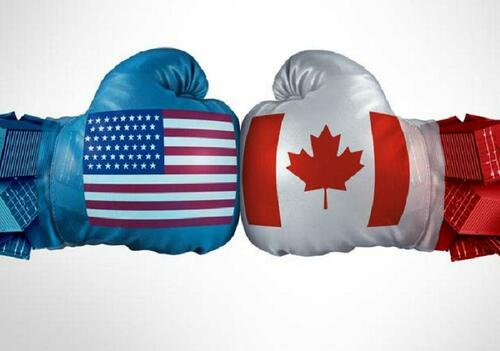Canada’s Economy Will Not Survive A Prolonged Trade War With The US
The ongoing trade war between the US and Canada barely registers on the radar for most of the American public, largely because it doesn’t affect their wallets in any significant way. However, on the Canadian side of the border, the economic conflict dominates headlines and discussion. Average Canadians face significant uncertainty and Canada’s export markets are teetering on the brink of crisis.
The lesson here? Perhaps it’s a bad idea to engage in brinkmanship with the US when the US buys 76% of your exports? Canada’s exports represent 33% of their total annual GDP, while US exports are only 10% of GDP. That is to say, Canada needs the US far more than the US needs Canada. The numbers are clear as day.
The Trump Administration’s recent announcement that all trade negotiations with Canada have been shut down requires some analysis of future consequences. The trigger for the cancellation was a Canadian ad aimed at US conservatives featuring excerpts of a Ronald Reagan speech with criticisms on tariffs.
According to the Ronald Reagan Foundation, the ad uses selective editing to present a false picture of Reagan’s position on trade protections. It is true that Reagan was generally a proponent of globalization, but he also instituted a number of protectionist policies during his two terms as US President. Reagan pressured Japanese car makers to adopt import restraints on automobiles, which remained in effect until 1985. Japan was told that if they did not accept the restraints, Congress would pass harsher measures.
Additionally, Reagan imposed protectionist measures on textiles, specialty steel, Canadian wood products, Italian pasta, motorcycles, and even mushrooms during his two terms. In 1986, Reagan threatened to impose a 200 percent tariff on Spain for its restrictions on U.S. grain imports.
That said, Reagan’s affinity for globalism also helped to accelerate the eventual collapse of US manufacturing jobs, which were ultimately outsourced to third world countries with cheap labor sources. The American middle class has been in steep decline ever since globalist policies were instituted.
Canada’s political advertisement is an attempt to exploit conservative nostalgia for the Reagan era while deliberately ignoring the nuances of his trade views. Not to mention, it shows that the Canadian government has no intention of addressing the parasitic relationship imposed on Americans through NAFTA and the USMCA. Numerous American industries have been crushed in the wake of these trade agreements.
Trump’s fury over Canada’s propaganda efforts is understandable, because it shows they would rather try to manipulate the American electorate rather than engage in sincere negotiations. This is a mistake on their part; manufacturing is now fleeing Canada.
Approximately 185,000 jobs have vanished in Canada since the beginning of the trade war. The majority of these jobs have come from the manufacturing sector. Companies shifting jobs away from Canada and to the US include: Stellantis, General Motors, and multiple steel producers. If tariffs continue, the country is projected to lose another 140,000 jobs by the end of 2025.
Canada’s GDP for 2025 is estimated to decline 2.6% to rest at 0.4%, equating to $78 billion in lost economic output. Prices also continue to skyrocket on basic necessities including food and housing.
Prime Minister Mark Carney has announced a plan to shift reliance on US markets and expand exports to other trading partners, but this plan is naive. The US represents 30% of all global consumer markets, and Canada has enjoyed the good fortune of sharing a border with the biggest single buyer of exports in the world. Meaning, the cost of moving goods is minimal, which maximizes profits for companies based in Canada. Trying to recreate these conditions with alternative buyers overseas is impossible.
Long term option for Canada include moving away from manufacturing and focusing on natural resources, which they have in abundance. Again, this still requires access to the US for any substantial exports, not to mention investments for exploration. As of 2023, the U.S. had a total FDI position of $452 billion in Canada across all sectors. This represents a significant portion of all foreign investment in the country.
Carney’s apparent arrogance on trade is perhaps driven by his progressive and globalist ideology, and as we have seen time and time again with the far-left, they don’t know how to admit they’re in over their heads. They only double down. Therefore, it’s likely that Carney will continue to blunder through negotiations with the US and lead Canada into economic disaster.
Tyler Durden
Fri, 10/24/2025 – 13:25ZeroHedge NewsRead More






 T1
T1


